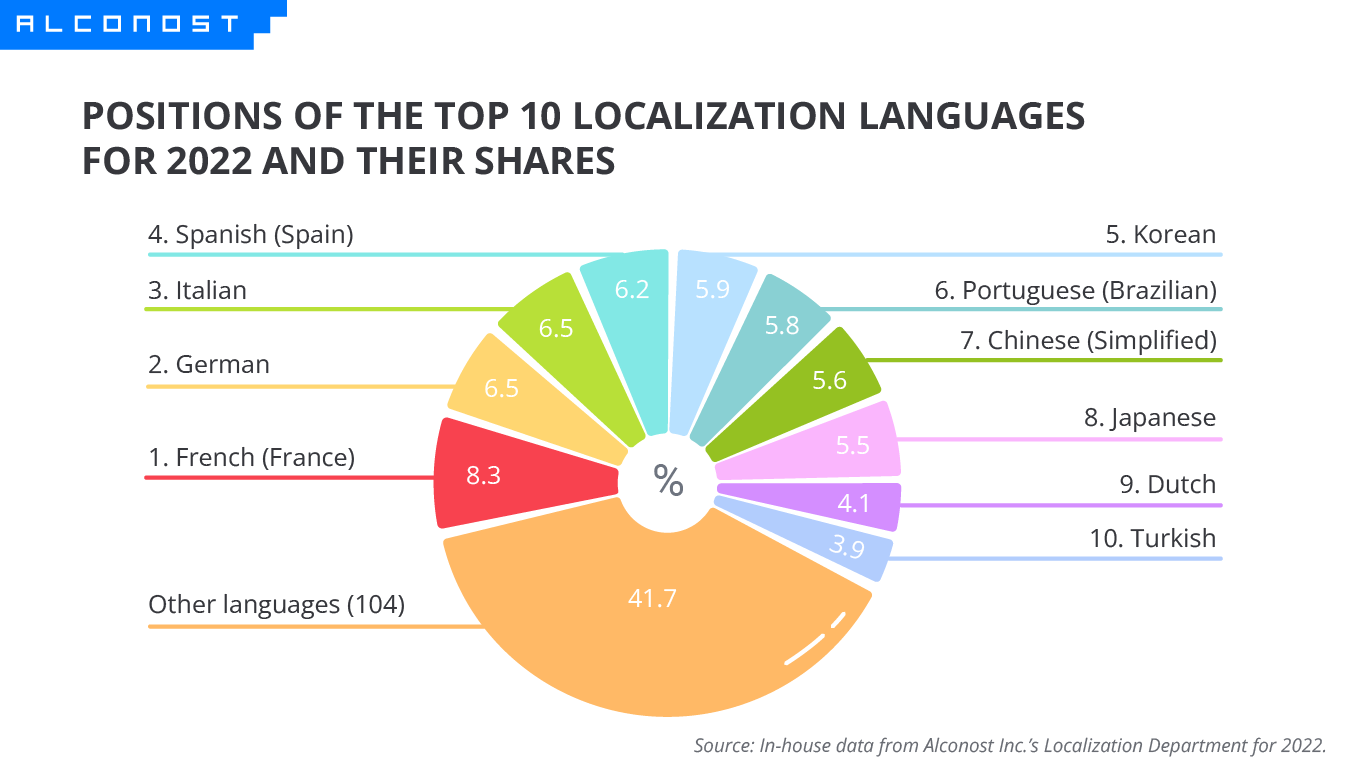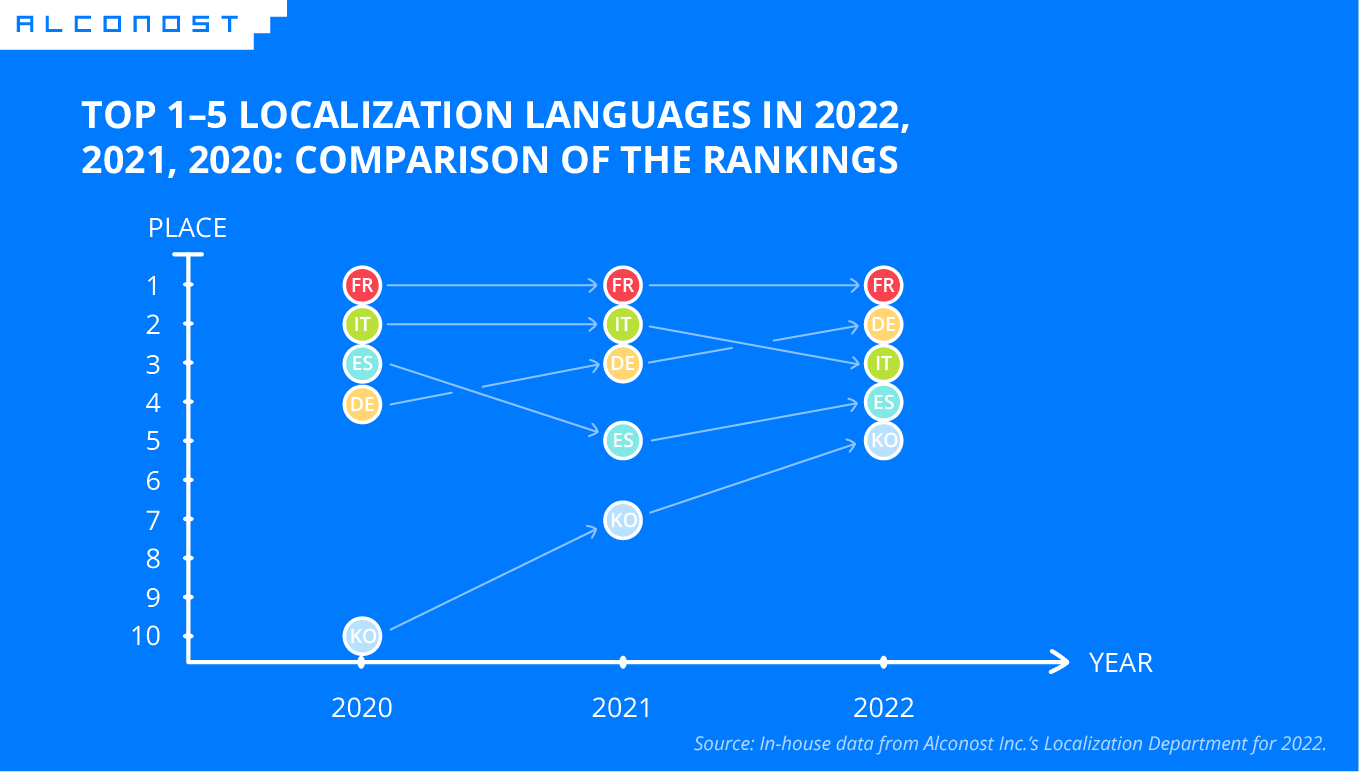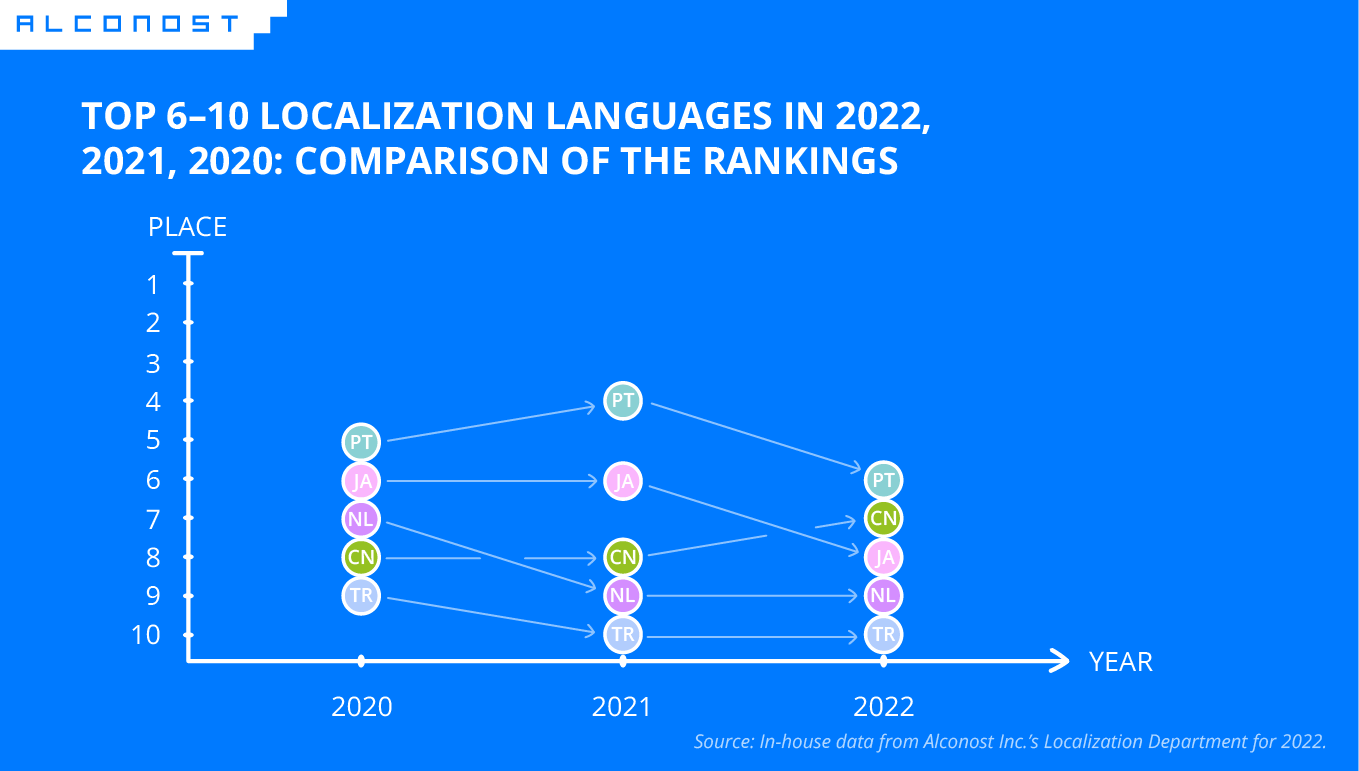- Resource Center
- Professional Development
- Articles & Videos
- 10 Languages For Localization From English: Numbers and Insights from Alconost
6 June 2023
| by Alconost
10 Languages For Localization From English: Numbers and Insights from Alconost
Localization agency Alconost has been sharing their in-house data on the most in-demand languages for localization since 2020. This year Alconost discloses which target languages were the most popular for localization from English in 2022.
Sign up for our newsletter on globalization and localization matters.
Key takeaways in 100 words
The most popular localization language in 2022 was French. Coming in behind French were German and Italian—neck and neck with each other, but with a big gap between them and the #1 spot. Following the top 3 was European Spanish.
Coming in 5th position for 2022 was Korean, moving up two spots from the previous year. Brazilian Portuguese dropped from 4th position in 2021 to 6th in 2022.
Simplified Chinese and Japanese made it to the 7th and 8th spots, respectively, in 2022. Closing out 2022's Top 10 were the same languages as in 2021: Dutch and Turkish.

Data source and details
- These data are based on in-house data from Alconost’s localization services department.
- Only orders with English as the source language were counted.
- Languages that have regional variations, such as Portuguese in Brazil vs. Portuguese in Europe, are considered separately.
- For this report, only orders placed through the Alconost localization services department were considered. Orders placed via Nitro, a human translation service run by Alconost, are not considered here.
Since Alconost has been publishing these stats for three years running, it now has enough data to trace the dynamics of how the demand for a particular language has changed over the years.
French: the undisputed leader
The French language (the European variety, not counting that of Canada and other regions) is a constant leader. Its share of Alconost's total orders consistently exceeds 8% for all three years, coming in at 8.2% and 8.7% in 2020 and 2021, respectively.
Localization into any language has its intricacies. When English is the source language and French is the target, one of the most common problems is the absence of the grammatical category of gender in English and its inevitable presence in French. This means that even when nouns, adjectives, and articles are ‘genderless’ in the source language, they will need to ‘acquire’ gender in the French localization.
For digital products, such as websites, apps, and games, this problem can be quite annoying since the source strings often contain variables. Since the variables may turn into words of different genders, this poses a risk to the concordance of the entire string, which may contain other gender-dependent parts of speech.
How to solve typical problems of French localization
The Alconost localization team helps their customers overcome this obstacle by suggesting ways to simplify the structure of the source strings. Not only does this lead to high-quality localization that native French speakers will appreciate, it also simplifies further localization of the product into other languages that have the same 'gender thing.' These languages include German, Italian, and Spanish, which have also consistently been among the top 5 target languages for localization in recent years.
If you're thinking of localizing your website, app, or software into French, consider adding support for French quotation marks, or guillemets («»), in addition to regular English quotation marks.
–Yana Tarasevich, localization project manager at Alconost.
And don't be surprised if the French edition of your product comes with spaces before and after guillemets or other punctuation marks.
This is in compliance with the punctuation rules of French, of which our native-speaking translators are well aware. What's more, to make the French localization look flawless once the localized strings are inserted in the product, our translators put a non-breaking space between the last letter and the punctuation mark, to avoid any accidental line breaks.
–Olga Matselya, Alconost localization manager.
German, Italian, and Spanish: still in demand

Together with French, these three languages are considered ‘the localization classics.’ German and Italian have been neck and neck in the localization race over the past three years. Their shares in the total number of orders ranges from 6.2% (German in 2020) to 6.6% (Italian in 2021).
From a practical standpoint, localizing from English into Italian or German usually results in a translated text approximately 17% longer than the original. This poses an additional problem for developers who need localizations to fit into their software’s interface.
If character limits for localized strings are strict, I would recommend allowing translators a certain degree of freedom, so that they can slightly reword strings to make them concise in the target language. With German, in some cases, one trick that can help is to create a compound noun—a single long word instead of several nouns with prepositions.
–Inna Kravchonok, Alconost localization manager.
Out of the current top 4, only European Spanish dipped below the 6% bar over the past three years, dropping to 5.9% in 2021. That year it was Brazilian Portuguese that held fourth place on the chart—the position that European Spanish currently holds with a 6.2% share.
(By the way, Brazilian Portuguese holds the 6th position in the 2022 rankings. Given that it held 4th place in 2021, does this mean that demand for the language is decreasing? Not exactly, because Brazilian Portuguese has only fluctuated in the rankings by one or two tenths of a percent in the past three years.)
In calculating the stats for Spanish, we only took localizations into the European variety into account. But if we had combined the orders performed in 2022 for all varieties of Spanish, including LATAM Spanish, Mexican Spanish, and country-specific variations such as Spanish in Argentina, Colombia, and several other countries, the total share of the Spanish language would have been 8.2%, or nearly equal to the #1 spot in our rankings.
Go east, young man
Korean is a regular in Alconost's Top 10, but it was only in 2022 that this language climbed to the 5th position in the rankings. “Given the growing worldwide interest in Korean mass culture, localizing a product into Korean can no longer be considered a foray into the exotic,” we wrote in an article about the top localization languages a year ago, and time has shown this to be true.
The demand for localization services into Simplified Chinese has remained steady over the past three years, maintaining 8th place in 2020 and 2021 and rising slightly to 7th in 2022. The share increase, however, is more impressive than the position hike—from 4.5% of orders in 2020 to 5.6% in 2022. Quite a jump!
(Please note that localization into Traditional Chinese is calculated separately. The demand for localization from English into Traditional Chinese is fairly stable, with its share hovering around 2.3% in 2022.)
Demand for localization into Japanese is quite interesting to analyze. If we look solely at the rankings, it may seem that demand is decreasing, with Japanese holding the 6th position in 2020 and 2021 before slipping to 8th place in 2022. But before jumping to conclusions, let’s consider its share of total orders, which is the same 5.5% in 2022 as it was the preceding year. The share has remained stable for two years in a row despite the fact that more and more target languages are being added each year (more on that a bit later).

Other languages in the Top 10 list
The Turkish language ranked 10th in the top localization languages for 2021 and 2022, while in 2020 it was slightly higher, in 9th place.
To complete the picture of the Top 10 languages, consider Dutch. In 2022 it ranked 9th, just as it had the previous year, although back to 2020 it had been in 7th place.
Overall, these languages are in constant and stable demand. If you select specific local markets for expansion, make sure that Turkey and the Netherlands weren’t overlooked in your preliminary research.
Localization trends: more languages, tailored processes
In 2020 and 2021, Alconost handled localization from English into 89 and 98 languages respectively. In 2022, we reached and passed the milestone of 100 target languages. Why, you may ask? The answer is demand.
Surpassing 110 target languages for localization from English was achieved through constant effort to satisfy requests from customers, mostly corporate clients, whose development plans require support for the languages of particular regions, such as Amharic, Bengali, Cebuano, and Dzongkha, to name just a few.
Localizing a product into multiple languages and maintaining localization updates requires a technical solution. When the scope is vast and the time is tight, you just can't rely exclusively on manual oversight.
In the case like this, customized localization solutions can be developed. This is especially true for enterprise translation needs. The fact that options like these are emerging proves that localization is increasingly being seen not as an exciting experiment but as an integral part of business processes.
I think there are at least two reasons for the gradually rising demand for localization process design. First, process design is pivotal for post-edited machine translation (PEMT) projects. These require a custom approach by their very nature, and they have to be cost-efficient at the same time. Second, a custom approach to localization workflow is essential for corporate customers seeking continuous localization solutions that fit their existing localization practices.
–Yoshiyuki Suginome, regional director of Alconost Japan and Asia-Pacific.
Do you want to contribute with an article, a blog post or a webinar?
We’re always on the lookout for informative, useful and well-researched content relative to our industry.



